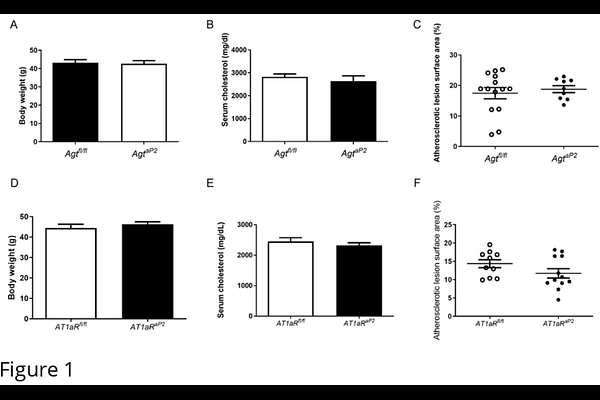Role of adipocyte angiotensinogen or angiotensin type 1a receptors in the development of diet-induced atherosclerosis or angiotensin II-induced abdominal aortic aneurysms

Role of adipocyte angiotensinogen or angiotensin type 1a receptors in the development of diet-induced atherosclerosis or angiotensin II-induced abdominal aortic aneurysms
AlSiraj, Y.; Putnam, K.; English, V.; Ensor, C. M.; Cassis, L. A.
AbstractAdipocytes express renin-angiotensin system (RAS) components, including angiotensinogen (Agt), the precursor to angiotensin II (AngII), and the angiotensin type 1a receptor (AT1aR). The RAS contributes to atherosclerosis, and AngII infusion causes abdominal aortic aneurysm (AAA) formation. Obesity, an established vascular risk factor, exhibits a dysregulated RAS. We studied effects of adipocyte Agt or AT1aR deficiency on diet-induced atherosclerosis and AngII-induced AAAs in male low density lipoprotein receptor (Ldlr) deficient mice. For atherosclerosis, male control or adipocyte Agt/AT1aR deficient mice were fed Western diet for 3 months. There was no effect of adipocyte Agt or AT1aR deficiency on body weight, serum cholesterol concentrations, or atherosclerotic lesions. For AngII-induced AAAs, male control and adipocyte Agt/AT1aR deficient Ldlr-/- mice fed Western diet were infused with AngII. Adipocyte Agt deficiency had no effect on body weight, serum cholesterol concentrations, abdominal aortic lumen diameter, AAA incidence, or atherosclerosis. Control, but not adipocyte AT1aR deficient mice lost weight during AngII infusion. The size of adipocytes in white fat was increased in adipocyte AT1aR deficient mice with no significant influences on abdominal aortic lumen diameter, AAA incidence, or atherosclerosis. To define mechanisms, male Ldlr-/- mice were fed standard or Western diet (1 or 3 months) and Agt or AT1aR mRNA abundance quantified in periaortic fat (PAF). Agt mRNA abundance in abdominal PAF increased over time in both diet groups, with modest diet-induced reductions in thoracic PAF Agt mRNA abundance. There was an effect of diet duration on AT1aR mRNA abundance in thoracic PAF, and an interaction between diet and time on abdominal PAF AT1aR mRNA abundance. In conclusion, adipocyte Agt or AT1aR deficiency had minimal effects on atherosclerosis or AngII-induced AAAs. However, adipocyte AT1aR deficient mice exhibited increased adipocyte size. Diet-induced regulation of Agt or AT1aR mRNA abundance in PAF may have contributed to these findings.